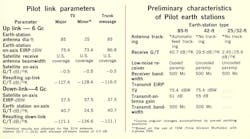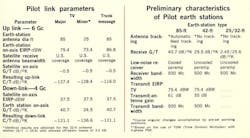News Item: November, 1967
Specifications call for two synchronous, fully stable satellites. Each would carry 12 transponders with 12 more as back-ups to assure 99.9 percent reliability for a five-year life span. Each satellite could handle either 12 color TV channels with 25-ft ground antennas or 21,600 trunk telephone channels with 85-ft dishes.
Approval of the system would open an important market for antennas and other ground equipment. The Comsat plan envisions four 85-ft antennas, two 42-ft antennas and up to 30 25- to 32-ft dishes. Instrumental to the proposal are low-cost, high-efficiency shaped-reflector dishes of the kind developed by Andrew Corp. A 32-ft antenna of this kind offers 50.8-dB gain with 72 percent efficiency.
Unlike earlier concepts, the domestic Pilot satellite would use only a single beam to cover the entire U.S., Canada and northern Mexico. Separate beams for each time zone are avoided by frequency and polarization diversity for each zone. The satellite antenna therefore would be a single 5 x 2.5-ft dish generating a 3 x 7-deg beam with 28-dB gain.
More Pilots are planned
Later, more sophisticated Pilots would include multiple beams for time-zone separation. Also in view are advanced Pilots for narrow-beam international service, aeronautical use and marine communications. Altogether, six versions of the Pilot system are contemplated.
Satellite microwave equipment is relatively straightforward. Of interest, however, is the use of tunnel-diode preamps and varactor-chain local oscillators. The satellite’s transponders are conventional TWT units of high reliability redundant design.
Microwave dollars aplenty ride with the FCC’s decision on Pilot. Antenna costs alone are estimated at about $15 million. Another $6.5 million is budgeted for the satellites, $300,000 for telemetry and control equipment and $240,000 for two transportable transmitters.


